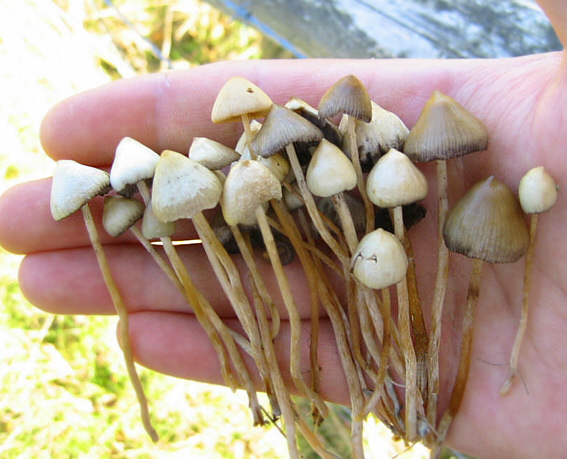- Psilocybe semilanceata
Taxobox
name = Psilocybe semilanceata

image_width = 230px
regnum = Fungi
divisio =Basidiomycota
classis =Hymenomycetes
ordo =Agaricales
familia =Strophariaceae
genus = "Psilocybe "
species = "P. semilanceata"
binomial = "Psilocybe semilanceata"
binomial_authority = (Fr.)P. Kumm. mycomorphbox
name = Psilocybe semilanceata
whichGills = adnate
whichGills2= adnexed
capShape = conical
capShape2=umbonate
hymeniumType=gills
stipeCharacter=bare
ecologicalType=saprotrophic
sporePrintColor=brown
sporePrintColor2=purple
howEdible=psychoactive"Psilocybe semilanceata" ("liberty cap") is a
psychedelic mushroom that contains the psychoactive compoundpsilocybin . It grows on grassy meadows and similar; particularly in wet, north-facing fields and other habitats well fertilized by sheep and cattle feces, although unlike "Psilocybe cubensis " it does not grow directly on the dung itself. It is found in fields where animals graze throughout the cool temperate and subarctic regions of theNorthern Hemisphere and it is most common in "Europe ,Russia ,India ,Peru and thePacific Northwest United States and Northeastern North America." [http://www.shroomery.org/6269/Ascent-and-Spread-of-Psilocybian-Consciousness Shroomery] ]Etymology
The mushroom takes its name from an actual cap, the
Phrygian cap , also known as the liberty cap, which it resembles. The Latin word for Phrygian cap is pileus, nowadays the technical name for what is commonly known as the "cap" of a fungal fruiting body. In the 18th century AD Phrygian caps were stuck onLiberty pole s, which resemble the stem of the mushroom. The binomial name can be broken down into the Greek "psilo" (bald) and "cybe" (head), and the Latin "semi" (half) and "lanceata" (lanced or pierced).Identification
Liberty caps have a distinctive conical head with a small point or nipple on the tip. They are yellow to brown in colour and the caps are slimy when moist. Their stems tend to be long, slightly wavy and the same colour or slightly lighter than the cap. The gills are darker than the outer cap. There are several species of lookalikes; domed heads and translucent stalks are some of the main giveaways when identifying impostors. As with all fungus, if in doubt do not consume before ascertaining the exact species. In Northern Europe (Finland, Sweden and Norway) it starts fruiting in August and fruits from September through December in central Europe and December through January in the United States.
Contemporary use in the UK
In Britain, a 'loophole' in UK law allowed the selling and possession of fresh, unprepared psychoactive mushrooms. After much indecision governmental forces closed the loop hole. As from July 18, 2005 all retail transactions involving psychoactive mushrooms became illegal (with the exception of
fly agaric ), and possession of practically all psychoactive mushrooms was made illegal under the Drugs Act of 2005. Any transgression is treatable as a criminal offense involving a Class A substance.Somewhat unsurprisingly, as is normally the way with any war on drugs and/or their use, the comprehensive curtailing of the legal market so suddenly resulted in a tremendous increase in the use of the liberty cap by people who can no longer obtain their substance of choice by retail. People that once would buy them occasionally in a shop turned to books and the internet to learn how to hunt/pick mushrooms in the wild, or even grow their own from spore kits.
Gallery
External links
* [http://images.google.com/images?q=%22Psilocybe+semilanceata%22 "Psilocybe semilanceata" (Google Images)]
* [http://www.tranexp.com:2000/Translate/index.shtml?from=che&to=eng&type=url&url=http%3A%2F%2Fwww.biopsia.wz.cz%2Fcap3.htm "Psilocybe semilanceata" Including Some Range Maps]ee also
*
Mushroom hunting
*Psilocybin mushrooms References
Wikimedia Foundation. 2010.
